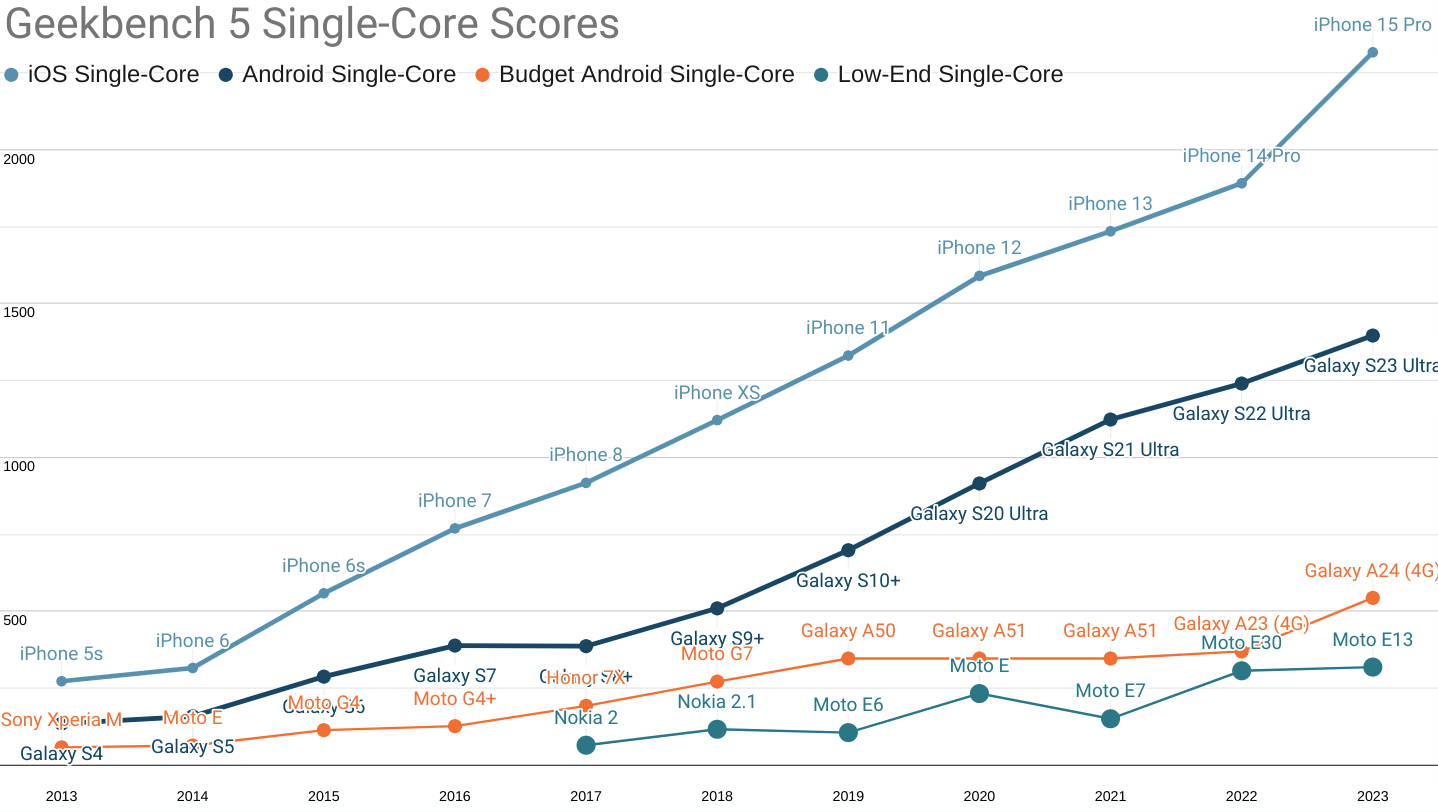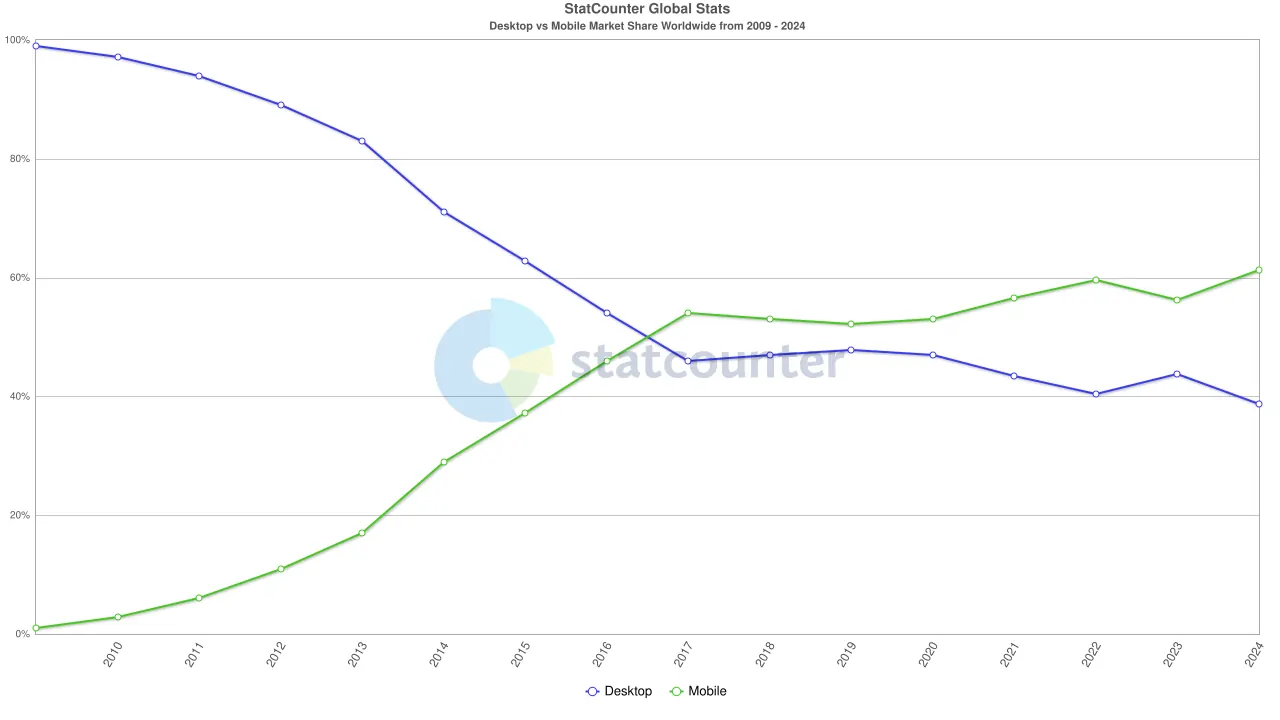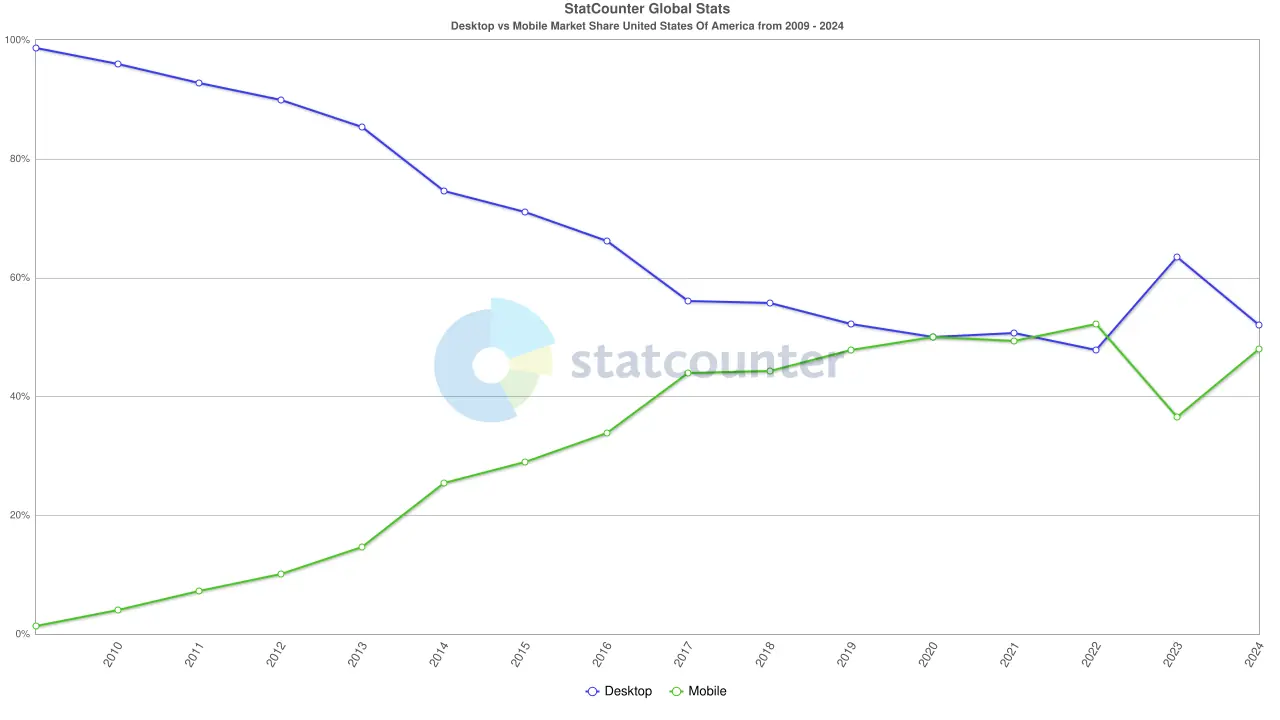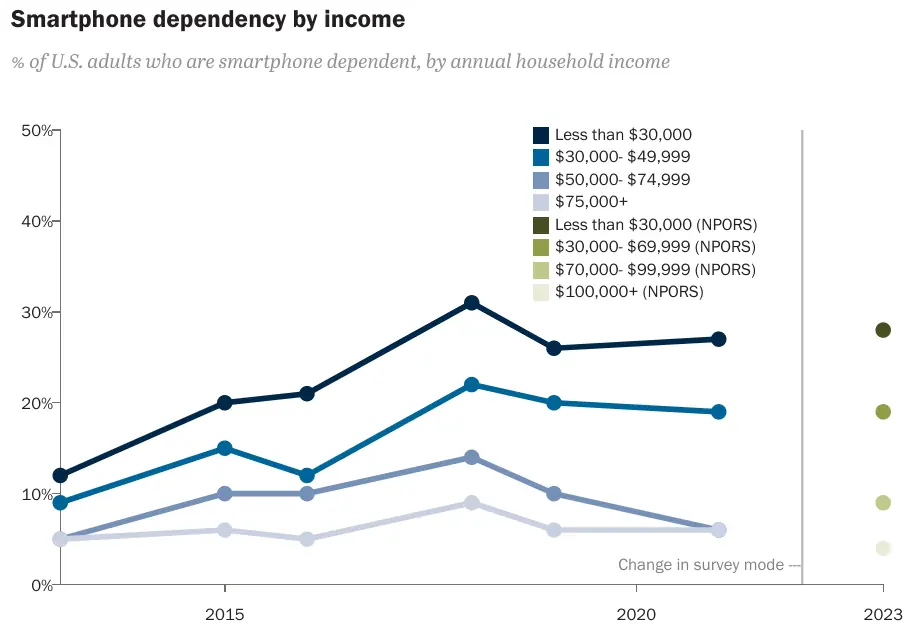Reckoning: Part 2 — Object Lesson
What hath we wrought? A case study.
Other posts in the series:
The Golden Wait #
BenefitsCal is the state of California's recently developed portal for families that need to access SNAP benefits (née "food stamps"):[1]
Code for America's getcalfresh.org performs substantially the same function, providing a cleaner, faster, and easier-to-use alternative to California county and state benefits applications systems:
The like-for-like, same-state comparison getcalfresh.org provides is unique. Few public sector services in the US have competing interfaces, and only Code for America was motivated to build one for SNAP applications.
WebPageTest.org timelines document a painful progression. Users can begin to interact with getcalfresh.org before the first (of three) BenefitsCal loading screens finish (scroll right to advance):
Google's Core Web Vitals data backs up test bench assessments. Real-world users are having a challenging time accessing the site:

But wait! There's more. It's even worse than it looks.
The multi-loading-screen structure of BenefitsCal fakes out Chrome's heuristic for when to record Largest Contentful Paint.
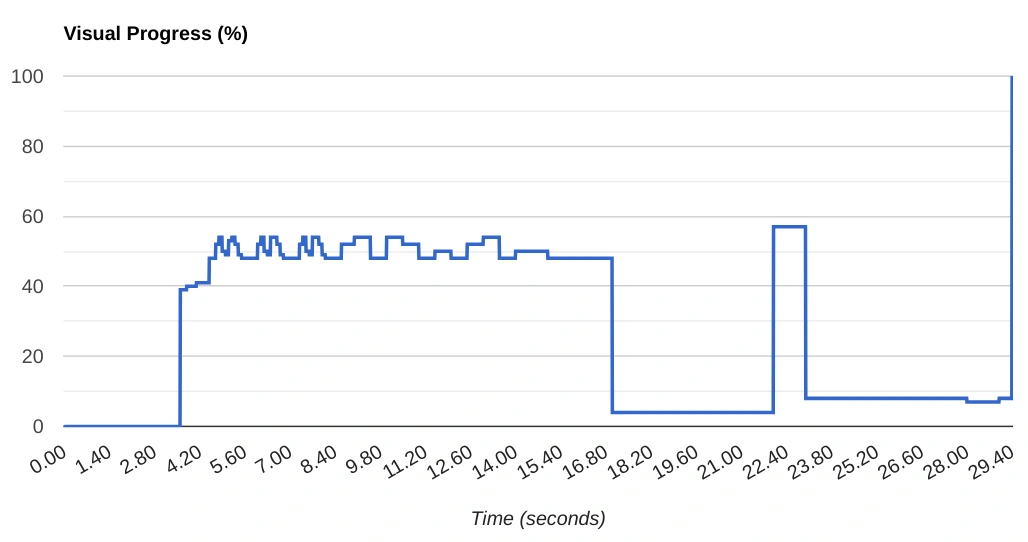
The real-world experience is significantly worse than public CWV metrics suggest.
Getcalfresh.org uses a simpler, progressively enhanced, HTML-first architecture to deliver the same account and benefits signup process, driving nearly half of all signups for California benefits (per CalSAWS).
The results are night-and-day:[2]

And this is after the state spent a million dollars on work to achieve "GCF parity".
The Truth Is In The Trace #
No failure this complete has a single father. It's easy to enumerate contributing factors from the WebPageTest.org trace, and a summary of the site's composition and caching make for a bracing read:
| File Type | First View | Repeat View | |||||
|---|---|---|---|---|---|---|---|
| Wire (KB) | Disk | Ratio | Wire | Disk | Ratio | Cached | |
| JavaScript | 17,435 | 25,865 | 1.5 | 15,950 | 16,754 | 1.1 | 9% |
| Other (text) | 1,341 | 1,341 | 1.0 | 1,337 | 1,337 | 1.0 | 1% |
| CSS | 908 | 908 | 1.0 | 844 | 844 | 1.0 | 7% |
| Font | 883 | 883 | N/A | 832 | 832 | N/A | 0% |
| Image | 176 | 176 | N/A | 161 | 161 | N/A | 9% |
| HTML | 6 | 7 | 1.1 | 4 | 4 | 1.0 | N/A |
| Total | 20,263 | 29,438 | 1.45 | 18,680 | 19,099 | 1.02 | 7% |
The first problem is that this site relies on 25 megabytes of JavaScript (uncompressed, 17.4 MB on over the wire) and loads all of it before presenting any content to users. This would be unusably slow for many, even if served well. Users on connections worse than the P75 baseline emulated here experience excruciating wait times. This much script also increases the likelihood of tab crashes on low-end devices.[3]
Very little of this code is actually used on the home page, and loading the home page is presumably the most common thing users of the site do:[4]
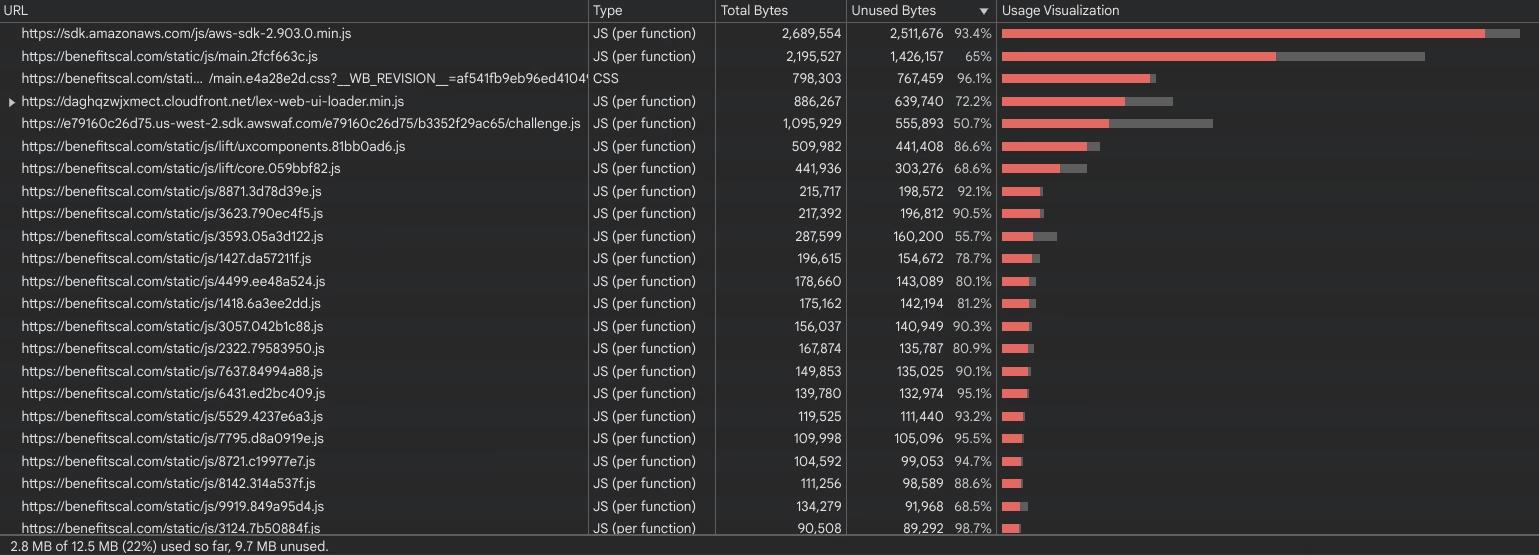
As bad as that is, the wait to interact at all is made substantially worse by inept server configuration. Industry-standard gzip compression generally results in 4:1-8:1 data savings for text resources (HTML, CSS, JavaScript, and "other") depending on file size and contents. That would reduce ~28 megabytes of text, currently served in 19MB of partially compressed resources, to between 3.5MB and 7MB.
But compression is not enabled for most assets, subjecting users to wait for 19MB of content. If CalSAWS built BenefitsCal using progressive enhancement, early HTML and CSS would become interactive while JavaScript filigrees loaded in the background. No such luck for BenefitsCal users on slow connections.
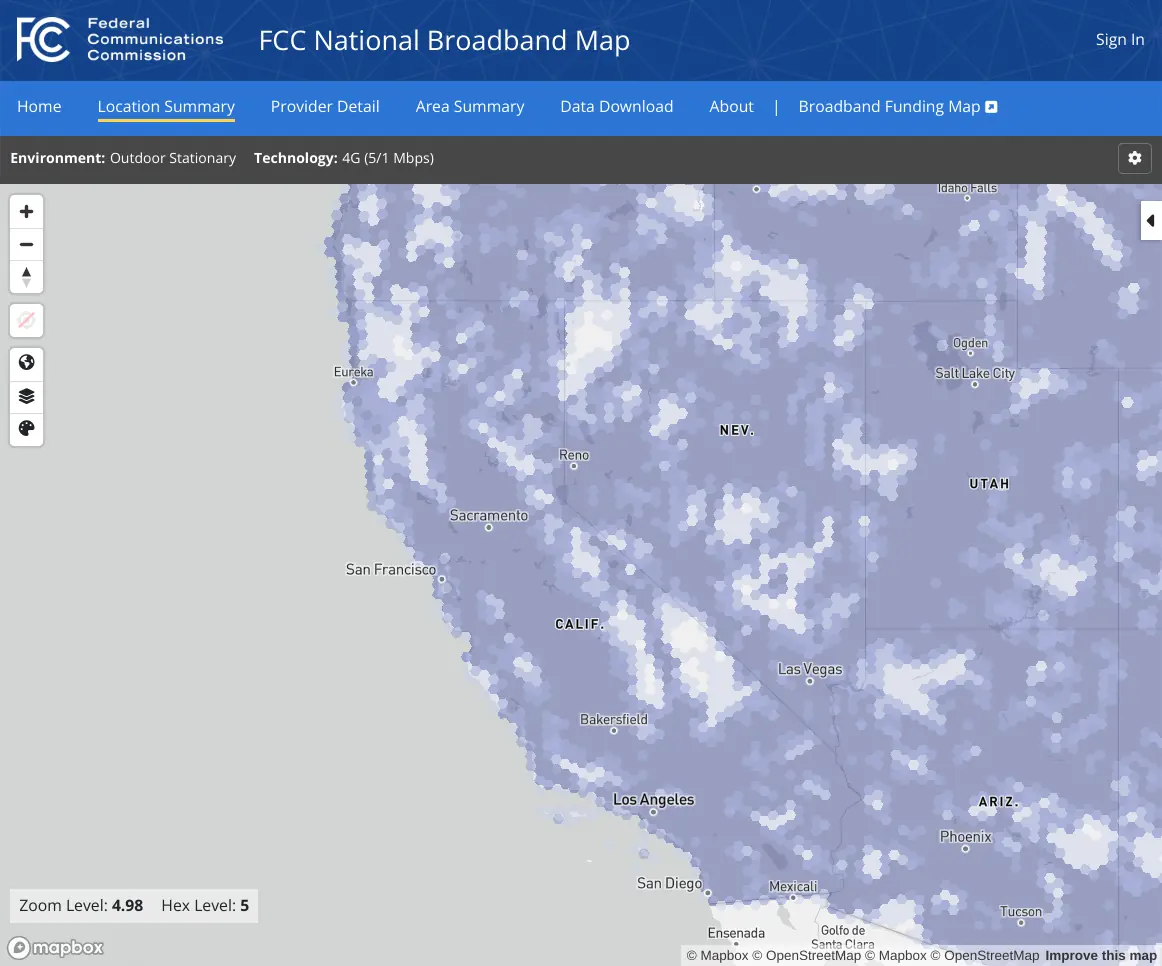
Thanks to the site's JavaScript-dependent, client-side rendered, single-page-app (SPA) architecture, nothing is usable until nearly the entire payload is downloaded and run, defeating built-in browser mitigations for slow pages. Had progressive enhancement been employed, even egregious server misconfigurations would have had a muted effect by comparison.[5]
Zip It #
Gzip compression has been industry standard on the web for more than 15 years, and more aggressive algorithms are now available. All popular web servers support compression, and some enable it by default. It's so common that nearly every web performance testing tool checks for it, including Google's PageSpeed Insights.[6]
Gzip would have reduced the largest script from 2.1MB to a comparatively svelte 340K; a 6.3x compression ratio:
$ gzip -k main.2fcf663c.js
$ ls -l
> total 2.5M
> ... 2.1M Aug 1 17:47 main.2fcf663c.js
> ... 340K Aug 1 17:47 main.2fcf663c.js.gzNot only does the site require a gobsmacking amount of data on first visit, it taxes users nearly the same amount every time they return.
Because most of the site's payload is static, the fraction cached between first and repeat views should be near 100%. BenefitsCal achieves just 7%.
This isn't just perverse; it's so far out of the norm that I struggled to understand how CalSAWS managed to so thoroughly misconfigure a web server modern enough to support HTTP/2.
The answer? Overlooked turnkey caching options in CloudFront's dashboard.[7]
This oversight might have been understandable at launch. The mystery remains how it persisted for nearly three years (pdf). The slower the device and network, the more sluggish the site feels. Unlike backend slowness, the effects of ambush-by-JavaScript can remain obscured by the fast phones and computers used by managers and developers.
But even if CalSAWS staff never leave the privilege bubble, there has been plenty of feedback:

'And it's so f'n slow.'
Having placed a bet on client-side rendering, CalSAWS, Gainwell, and Deloitte staff needed to add additional testing and monitoring to assess the site as customers experience it. This obviously did not happen.
The most generous assumption is they were not prepared to manage the downsides of the complex and expensive JavaScript-based architecture they chose over progressive enhancement.[8][9]
Near Peers #
Analogous sites from other states point the way. For instance, Wisconsin's ACCESS system:
There's a lot that could be improved about WI ACCESS's performance. Fonts are loaded too late, and some of the images are too large. They could benefit from modern formats like WebP or AVIF. JavaScript could be delay-loaded and served from the same origin to reduce connection setup costs. HTTP/2 would left-shift many of the early resources fetched in this trace.
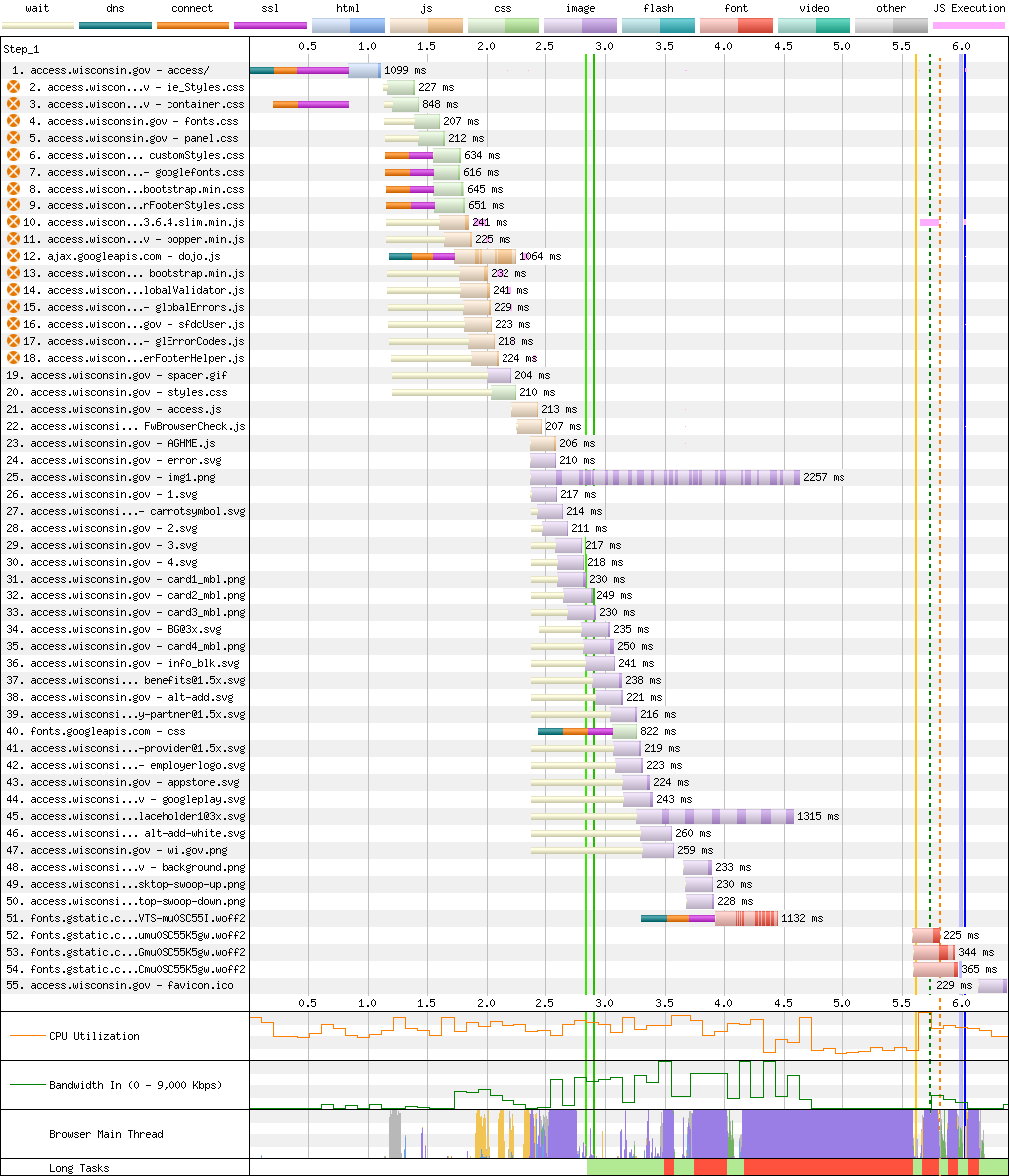
But the experience isn't on fire, listing, and taking on water.

Because the site is built in a progressively enhanced way, simple fixes can cheaply and quickly improve on an acceptable baseline.
Even today's "slow" networks and phones are so fast that sites can commit almost every kind of classic error and still deliver usable experiences. Sites like WI ACCESS would have felt sluggish just 5 years ago but work fine today. It takes extra effort to screw up as badly as BenefitsCal has.
Blimey #
To get a sense of what's truly possible, we can compare a similar service from the world leader in accessible, humane digital public services: gov.uk, a.k.a., the UK Government Digital Service (GDS).
California enjoys a larger GDP and a reputation for technology excellence, and yet the UK consistently outperforms the Golden State's public services.
There are layered reasons for the UK's success:
- GDS's Service Manual is an enforceable guide for how government services should be built and delivered continuously. This liberates each department from reinventing processes or rediscovering how best to deliver through trial and error.
- The GDS Service Manual requires progressive-enhancement.
- Progressive Enhancement is baked into infrastructure and practice by patterns long documented in the official GDS design system and reference implementation.
- The parallel Service Standard clearly articulates the egalitarian, open values that every delivery team is held to.
- The Service Manual and Service Standard nearly shout "do not write an omnibus contract!" if you can read between the lines. The interlocking processes, spend controls, and agile activism serve to grind down too-big-to-fail procurement into a fine powder, one contract at a time.[10]
The BenefitsCal omnishambles should trigger a fundamental rethink. Instead, the prime contractors have just been awarded another $1.3BN over a long time horizon. CalSAWS is now locked in an exclusive arrangement with the very folks that broke the site with JavaScript. Any attempt at fixing it now looks set to reward easily-avoided failure.
Too-big-to-fail procurement isn't just flourishing in California; it's thriving across public benefits application projects nationwide. No matter how badly service delivery is bungled, the money keeps flowing.
JavaScript Masshattery #
CalSAWS is by no means alone.
For years, I have been documenting the inequality exacerbating effects of JS-based frontend development based on the parade of private-sector failures that cross my desk.[11]
Over the past decade, those failures have not elicited a change in tone or behaviour from advocates for frameworks, but that might be starting to change, at least for high-traffic commercial sites.
Core Web Vitals is creating pressure on slow sites that value search engine traffic. It's less clear what effect it will have on public-sector monopsonies. The spread of unsafe-at-any-scale JavaScript frameworks into government is worrying as it's hard to imagine what will dislodge them. There's no comparison shopping for food stamps.[12]
The Massachusetts Executive Office of Health and Human Services (EOHHS) seems to have fallen for JavaScript marketing hook, line, and sinker.
DTA Connect is the result, a site so slow that it frequently takes me multiple attempts to load it from a Core i7 laptop attached to a gigabit network.
From the sort of device a smartphone-dependent mom might use to access the site? It's lookin' slow.
I took this trace multiple times, as WebPageTest.org kept timing out. It's highly unusual for a site to take this long to load. Even tools explicitly designed to emulate low-end devices and networks needed coaxing to cope.
The underlying problem is by now familiar:

Vexingly, whatever hosting infrastructure Massachusetts uses for this project throttles serving to 750KB/s. This bandwidth restriction combines with server misconfigurations to ensure the site takes forever to load, even on fast machines.[13]
It's a small mercy that DTA Connect sets caching headers, allowing repeat visits to load in "only" several seconds. Because of the SPA architecture, nothing renders until all the JavaScript gathers its thoughts at the speed of the local CPU.
The slower the device, the longer it takes.[14]
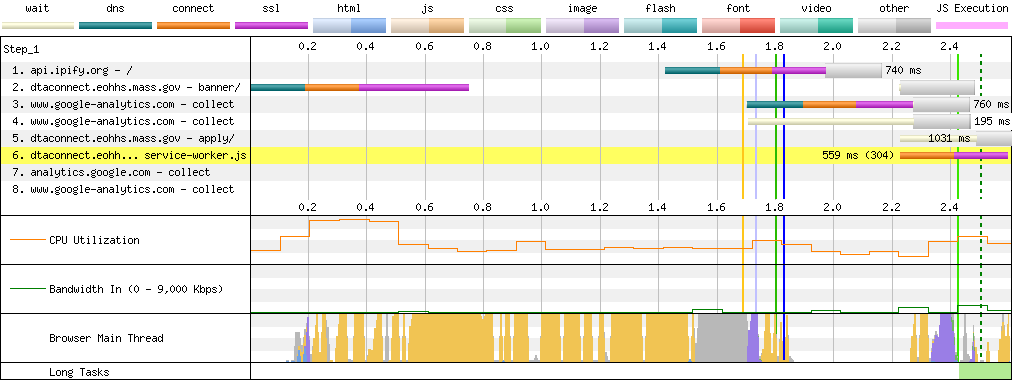
A page this simple, served entirely from cache, should render in much less than a second on a device like this.[15]
Maryland Enters The Chat #
The correlation between states procuring extremely complex, newfangled JavaScript web apps and fumbling basic web serving is surprisingly high.
Case in point, the residents of Maryland wait seconds on a slow connection for megabytes of uncompressed JavaScript, thanks to the Angular 9-based SPA architecture of myMDTHINK.[16]

American legislators like to means test public services. In that spirit, perhaps browsers should decline to load multiple megabytes of JavaScript if a site can't manage gzip.
Chattanooga Chug Chug #
Tennessee, a state with higher-than-average child poverty, is at least using JavaScript to degrade the accessibility of its public services in unique ways.
Instead of misconfiguring web servers, The Volunteer State uses Angular to synchronously fetch JSON files that define the eventual UI in an onload event handler.


Needless to say, this does not read to the trained eye as competent work.
SNAP? In Jersey? Fuhgeddaboudit #
New Jersey's MyNJHelps.gov (yes, that's the actual name) mixes the old-timey slowness of multiple 4.5MB background stock photos with a nu-skool render-blocking Angular SPA payload that's 2.2MB on the wire (15.7MB unzipped), leading to first load times north of 20 seconds.
Despite serving the oversized JavaScript payload relatively well, the script itself is so slow that repeat visits take nearly 13 seconds to display fully:
What Qualcomm giveth, Angular taketh away.

Debugging the pathologies of this specific page are beyond the scope of this post, but it is a mystery how New Jersey managed to deploy an application that triggers a debugger; statement on every page load with DevTools open whilst also serving a 1.8MB (13.8MB unzipped) vendor.js file with no minification of any sort.
One wonders if anyone involved in the deployment of this site are developers, and if not, how it exists.
Hoosier Hospitality #
Nearly half of the 15 seconds required to load Indiana's FSSA Benefits Portal is consumed by a mountain of main-thread time burned in its 4.2MB (16MB unzipped) Angular 8 SPA bundle.
Combined with a failure to set appropriate caching headers, both timelines look identically terrible:
Can you spot the difference?


Deep Breaths #
The good news is that not every digital US public benefits portal has been so thoroughly degraded by JavaScript frameworks. Code for America's 2023 Benefits Enrollment Field Guide study helpfully ran numbers on many benefits portals, and a spot check shows that those that looked fine last year are generally in decent shape today.
Still, considering just the states examined in this post, one in five US residents will hit underperforming services, should they need them.
None of these sites need to be user hostile. All of them would be significantly faster if states abandoned client-side rendering, along with the legacy JavaScript frameworks (React, Angular, etc.) built to enable the SPA model.
GetCalFresh, Wisconsin, and the UK demonstrate a better future is possible today. To deliver that better future and make it stick, organisations need to learn the limits of their carrying capacity for complexity. They also need to study how different architectures fail in order to select solutions that degrade more gracefully.
Next: Caprock: Development without constraints isn't engineering.
Thanks to Marco Rogers, and Frances Berriman for their encouragement in making this piece a series and for their thoughtful feedback on drafts.
If you work on a site discussed in this post, I offer (free) consulting to public sector services. Please get in touch.
The JavaScript required to render anything on BenefitsCal embodies nearly every anti-pattern popularised (sometimes inadvertently, but no less predictably) by JavaScript influencers over the past decade, along with the most common pathologies of NPM-based frontend development.
A perusal of the code reveals:
- Multiple reactive frontend frameworks, namely React, Vue, and RxJS.
- "Client-side routing" metadata for the entire site bundled into the main script.
- React components for all UI surfaces across the entire site, including:
- Components for every form, frontloaded. No forms are displayed on the home page.
- An entire rich-text editing library. No rich-text editing occurs on the home page.
- A complete charting library. No charts appear on the home page.
- Sizable custom scrolling and drag-and-drop libraries. No custom scrolling or drag-and-drop interactions occur on the home page.
- A so-called "CSS-in-JS" library that does not support compilation to an external stylesheet. This is categorically the slowest and least efficient way to style web-based UIs. On its own, it would justify remediation work.
- Unnecessary polyfills and transpilation overhead, including:
classsyntax transpilation.- Generator function transpilation and polyfills independently added to dozens of files.
- Iterator transpilation and polyfills.
- Standard library polyfills, including obsolete userland implementations of
ArrayBuffer,Object.assign()and repeated inlining of polyfills for many others, including a litany of outdated TypeScript-generated polyfills, bloating every file. - Obselete DOM polyfills, including a copy of Sizzle to provide emulation for
document.querySelectorAll()and a sizable colourspace conversion system, along with userland easing functions for all animations supported natively by modern CSS.
- No fewer than
2...wait...5...no, 6 large — seemingly different! —User-Agentparsing libraries that support browsers as weird and wonderful as WebOS, Obigo, and iCab. What a delightful and unexpected blast from the past! (pdf) - What appears to be an HTML parser and userland DOM implementation!?!
- A full copy of Underscore.
- A full copy of Lodash.
- A full copy of
core-js. - A userland elliptic-curve cryptography implementation. Part of an on-page chatbot, naturally.
- A full copy of Moment.js. in addition to the custom date and time parsing functions already added via bundling of the (overlarge)
react-date-pickerlibrary. - An unnecessary OAuth library.
- An emulated version of the Node.js
bufferclass, entirely redundant on modern browsers. - The entire Amazon Chime SDK, which includes all the code needed to do videoconferencing. This is loaded in the critical path and alone adds multiple megabytes of JS spread across dozens of webpack-chunked files. No features of the home page appear to trigger videoconferencing.
- A full copy of the AWS JavaScript SDK, weighing 2.6MB, served separately.
- Obviously, nothing this broken would be complete without a Service Worker that only caches image files.
This is, to use the technical term, whack.
The users of BenefitsCal are folks on the margins — often working families — trying to feed, clothe, and find healthcare for kids they want to give a better life. I can think of few groups that would be more poorly served by such baffling product and engineering mismanagement. ↩︎ ↩︎
getcalfresh.org isn't perfect from a performance standpoint.
The site would feel considerably snappier if the heavy chat widget it embeds were loaded on demand with the facade pattern and if the Google Tag Manager bundle were audited to cut cruft. ↩︎
Browser engineers sweat the low end because that's where users are[17], and when we do a good job for them, it generally translates into better experiences for everyone else too. One of the most durable lessons of that focus has been that users having a bad time in one dimension are much more likely to be experiencing slowness in others.
Slow networks correlate heavily with older devices that have less RAM, slower disks, and higher taxes from "potentially unwanted software" (PUS). These machines may experience malware fighting with invasive antivirus, slowing disk operations to a crawl. Others may suffer from background tasks for app and OS updates that feel fast on newer machines but which drag on for hours, stealing resources from the user's real work the whole time.
Correlated badness also means that users in these situations benefit from any part of the system using fewer resources. Because browsers are dynamic systems, reduced RAM consumption can make the system faster, both through reduced CPU load from zram, as well as rebalancing in auto-tuning algorithms to optimise for speed rather than space.
The pursuit of excellent experiences at the margins is deep teacher about the systems we program, and a frequently humbling experience. If you want to become a better programmer or product manager, I recommend focusing on those cases. You'll always learn something. ↩︎
It's not surprising to see low code coverage percentages on the first load of an SPA. What's shocking is that the developers of BenefitsCal confused it with a site that could benefit from this architecture.
To recap: the bet that SPA-oriented JavaScript frameworks make is that it's possible to deliver better experiences for users when the latency of going to the server can be shortcut by client-side JavaScript.
I cannot stress this enough: the premise of this entire wing of web development practice is that expensive, complex, hard-to-operate, and wicked-to-maintain JavaScript-based UIs lead to better user experiences.
It is more than fair to ask: do they?
In the case of BenefitsCal and DTA Connect, the answer is "no".
The contingent claim of potentially improved UI requires dividing any additional up-front latency by the number of interactions, then subtracting the average improvement-per-interaction from that total. It's almost impossible to imagine any app with sessions long enough to make 30-second up-front waits worthwhile, never mind a benefits application form.
These projects should never have allowed "frontend frameworks" within a mile of their git repos. That they both picked React (a system with a lurid history of congenital failure) is not surprising, but it is dispiriting.
Previous posts here have noted that site structure and critical user journeys largely constrain which architectures make sense:
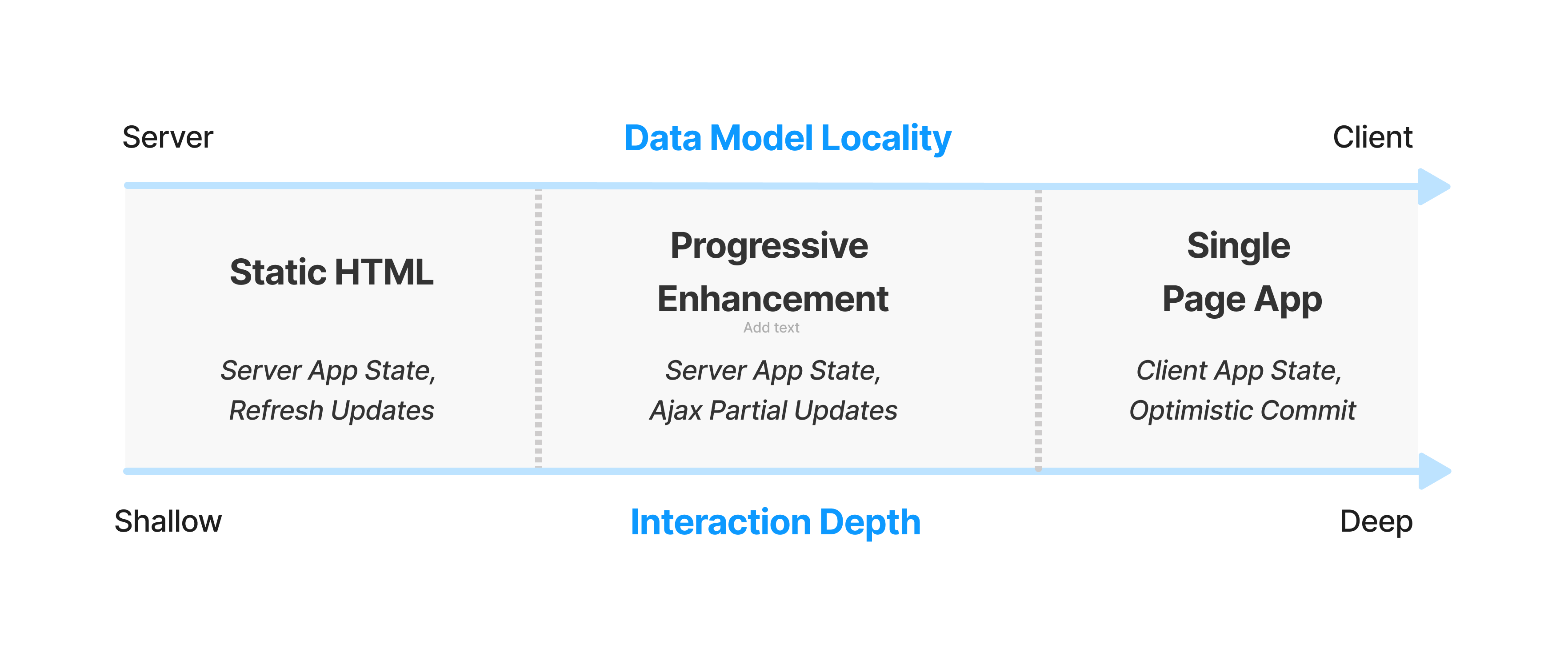
Sites with short average sessions cannot afford much JS up-front. These portals serve many functions: education, account management, benefits signup, and status checks. None of these functions exhibit the sorts of 50+ interaction sessions of a lived-in document editor (Word, Figma) or email client (Gmail, Outlook). They are not "toothbrush" services that folks go to every day, or which they use over long sessions.
Even the sections that might benefit from additional client-side assistance (rich form validation, e.g.) cannot justify loading all of that code up-front for all users.
The failure to recognise how inappropriate JavaScript-based SPA architectures are for most sites is an industry-wide scandal. In the case of these services, that scandal takes on whole new dimension of reckless irresponsibility. ↩︎
JavaScript-based SPAs yank the reins away from the browser while simultaneously frontloading code at the most expensive time.
SPA architectures and the frameworks built to support them put total responsibility for all aspects of site performance squarely on the shoulders of the developer. Site owners who are even occasionally less than omniscient can quickly end up in trouble. It's no wonder many teams I work with are astonished at how quickly these tools lead to disastrous results.
SPAs are "YOLO" for web development.
Their advocates' assumption of developer perfection is reminiscent of C/C++'s approach to memory safety. The predictable consequences should be enough to disqualify them from use in most new work. The sooner these tools and architectures are banned from the public sector, the better. ↩︎
Confoundingly, while CalSAWS has not figured out how to enable basic caching and compression, it has rolled out firewall rules that prevent many systems like PageSpeed Insights from evaluating the page through IP blocks.
The same rules also prevent access from IPs geolocated to be outside the US. Perhaps it's also a misconfiguration? Surely CalSAWS isn't trying to cut off access to services for users who are temporarialy visiting family in an emergency, right? ↩︎
There's a lot to say about BenefitsCal's CloudFront configuration debacle.
First, and most obviously: WTF, Amazon?
It's great that these options are single-configuration and easy to find when customers go looking for them, but they should not have to go looking for them. The default for egress-oriented projects should be to enable this and then alert on easily detected double-compression attempts.
Second: WTF, Deloitte?
What sort of C-team are you stringing CalSAWS along with? Y'all should be ashamed. And the taxpayers of California should be looking to claw back funds for obscenely poor service.
Lastly: this is on you, CalSAWS.
As the procurer and approver of delivered work items, the failure to maintain a minimum level of in-house technical skill necessary to call BS on vendors is inexcusable.
New and more appropriate metrics for user success should be integrated into public reporting. That conversation could consume an entire blog post; the current reports are little more than vanity metrics. The state should also redirect money it is spending with vendors to enhance in-house skills in building and maintaining these systems directly.
It's an embarrassment that this site is as broken as it was when I began tracing it three years ago. It's a scandal that good money is being tossed after bad. Do better. ↩︎
It's more likely that CalSAWS are inept procurers and that Gainwell + Deloitte are hopeless developers.
The alternative requires accepting that one or all of these parties knew better and did not act, undermining the struggling kids and families of California in the process. I can't square that with the idea of going to work every day for years to build and deliver these services. ↩︎
In fairness, building great websites doesn't seem to be Deloitte's passion.

Deloitte.com performs poorly for real-world users, a population that presumably includes a higher percentage of high-end devices than other sites traced in this post. But even Deloitte could have fixed the BenefitsCal mess had CalSAWS demanded better. ↩︎
It rankles a bit that what the UK's GDS has put into action for the last decade is only now being recognised in the US.
If US-centric folks need to call these things "products" instead of "services" to make the approach legible, so be it! Better late than never. ↩︎
I generally have not not posted traces of the private sector sites I have spent much of the last decade assisting, preferring instead to work quietly to improve their outcomes.
The exception to this rule is the public sector, where I feel deeply cross-pressured about the sort of blow-back that underpaid civil servants may face. However, sunlight is an effective disinfectant, particularly for services we all pay for. The tipping point in choosing to post these traces is that by doing so, we might spark change across the whole culture of frontend development. ↩︎
getcalfresh.org is the only direct competitor I know of to a state's public benefits access portal, and today it drives nearly half of all SNAP signups in California. Per BenefitsCal meeting notes (pdf), it is scheduled to be decommissioned next year.
Unless BenefitsCal improves dramatically, the only usable system for SNAP signup in the most populous state will disappear when it goes. ↩︎
Capping the effective bandwidth of a server is certainly one way to build solidarity between users on fast and slow devices.
It does not appear to have worked.
The glacial behaviour of the site for all implies managers in EOHHS must surely have experienced DTA Connect's slowness for themselves and declined to do anything about it. ↩︎
The content and structure of DTA Connect's JavaScript are just as horrifying as BenefitsCal's[1:1] and served just as poorly. Pretty-printed, the main bundle runs to 302,316 lines.
I won't attempt nearly as exhaustive inventory of the #fail it contains, but suffice to say, it's a Create React App special. CRAppy, indeed.
Many obsolete polyfills and libraries are bundled, including (but not limited to):
- A full copy of core-js
- Polyfills for features as widely supported as
fetch() - Transpilation down to ES5, with polyfills to match
- A full userland elliptic-curve cryptography library
- A userland implementation of BigInt
- A copy of zlib.js
- A full copy of the Public Suffix List
- A full list of mime types (thousands of lines).
- What appears to be a relatively large rainbow table.
Seasoned engineers reading this list may break out in hives, and that's an understandable response. None of this is necessary, and none of it is useful in a modern browser. Yet all of it is in the critical path.
Some truly unbelievable bloat is the result of all localized strings for the entire site occurring in the bundle. In every supported language.
Any text ever presented to the user is included in English, Spanish, Portuguese, Chinese, and Vietnamese, adding megabytes to the download.
A careless disregard for users, engineering, and society permeates this artefact. Massachusetts owes citizens better. ↩︎
Some junior managers still believe in the myth of the "10x" engineer, but this isn't what folks mean when they talk about "productivity". Or at least I hope it isn't. ↩︎
Angular is now on version 18, meaning Maryland faces a huge upgrade lift whenever it next decides to substantially improve myMDTHINK. ↩︎
Browsers port to macOS for CEOs, hipster developers, and the tech press. Macs are extremely niche devices owned exclusively by the 1-2%. Its ~5% browsing share is inflated by the 30% not yet online, almost none of whom will be able to afford Macs.
Wealth-related factors also multiply the visibility of high-end devices (like Macs) in summary statistics. These include better networks and faster hardware, both of which correlate with heavier browsing. Relatively high penetration in geographies with strong web use also helps. For example, Macs have 30% share of desktop-class sales in the US, vs 15% worldwide..
The overwhelming predominance of smartphones vs. desktops seals the deal. In 2023, smartphones outsold desktops and laptops by more than 4:1. This means that smartphones outnumber laptops and desktops to an even greater degree worldwide than they do in the US.
Browser makers keep Linux ports ticking over because that's where developers live (including many of their own). It's also critical for the CI/CD systems that power much of the industry.
Those constituencies are vocal and wealthy, giving them outsized influence. But iOS and and macOS aren't real life; Android and Windows are, particularly their low-end, bloatware-filled expressions.
Them's the breaks. ↩︎
